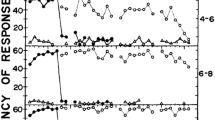Abstract
A three-phase model useful in teaching the analysis of behavior is presented. The model employs a “black box” behavior inventory diagram (BID), with a single output arrow representing behavior and three input arrows representing stimulus field, reversible states, and conditioning history. The first BID describes the organism at Time 1, and the second describes it at Time 2. Separating the two inventory diagrams is a column for the description of the intervening procedure. The model is used as a one-page handout, and students fill in the corresponding empty areas on the sheet as they solve five types of application problems. Instructors can use the BID to shape successive approximations in the accurate use of behavior-analytic vocabulary, conceptual analysis, and applications of behavior-change strategies.
Similar content being viewed by others
References
Allport, G. W. (1937). Personality: A psychological interpretation. New York: Holt.
Ashby, W. R. (1956). Introduction to cybernetics. New York: John Wiley.
Brunswik, E. (1952). The conceptual framework of psychology. In International encyclopedia of unified science (Vol. 1, No. 10). Chicago: University of Chicago Press.
Hummel, J. H., Kaeck, D. J., & Bowes, R. L. (1994). Diagramming operant processes. The ABA Newsletter, 17 (2), 4–5.
Keister, W., Ritchie, A. E., & Washburn, S. H. (1951). The design of switching circuits. New York: Van Nostrand.
Keller, F. S., & Schoenfeld, W. N. (1950). Principles of psychology: A systematic analysis. New York: Appleton-Century-Crofts.
Malott, R. W, Whaley, D. L., & Malott, M. E. (1993). Elementary principles of behavior. Englewood Cliffs, NJ: Prentice-Hall.
Mechner, F. (1959). A notation system for the description of behavioral procedures. Journal of the Experimental Analysis of Behavior, 2, 133–150.
Michael, J. (1982). Distinguishing between discriminative and motivational functions of stimuli. Journal of the Experimental Analysis of Behavior, 37, 149–155.
Morse, W. H., & Skinner, B. F. (1957). A second type of “superstition” in the pigeon. American Journal of Psychology, 70, 308–311.
Pavlov, I. P. (1927). Conditioned reflexes. London: Oxford University Press.
Schoenfeld, W. N., Cole, B. K., Blaustein, J., Lachter, G. D., Martin, J. M., & Vickery, C. (1972). Stimulus schedules. New York: Harper & Row.
Skinner, B. F. (1938). The behavior of organisms: An experimental analysis. New York: Appleton-Century-Crofts.
Skinner, B. F. (1948). “Superstition” in the pigeon. Journal of Experimental Psychology, 38, 168–172.
Snapper, A. G., Kadden, R. M., & Inglis, G. B. (1982). State notation of behavioral procedures. Behavior Research Method and Instrumentation, 14, 329–342.
Tolman, E. C. (1941). Discrimination vs. learning and the schematic sowbug. Psychological Review, 48, 367–382.
Tolman, E. C. (1951). A psychological model. In T. Parsons & E. A. Shils (Eds.), Toward a general theory of action (pp. 239–361). Cambridge, MA: Harvard University Press.
Watson, J. B., & Raynor, R. (1920). Conditioned emotional reactions. Journal of Experimental Psychology, 3, 1–14.
Woods, P. J. (1974). A taxonomy of instrumental conditioning. American Psychologist, 29, 584–597.
Woodworth, R. S. (1918). Dynamic psychology. New York: Columbia University Press.




